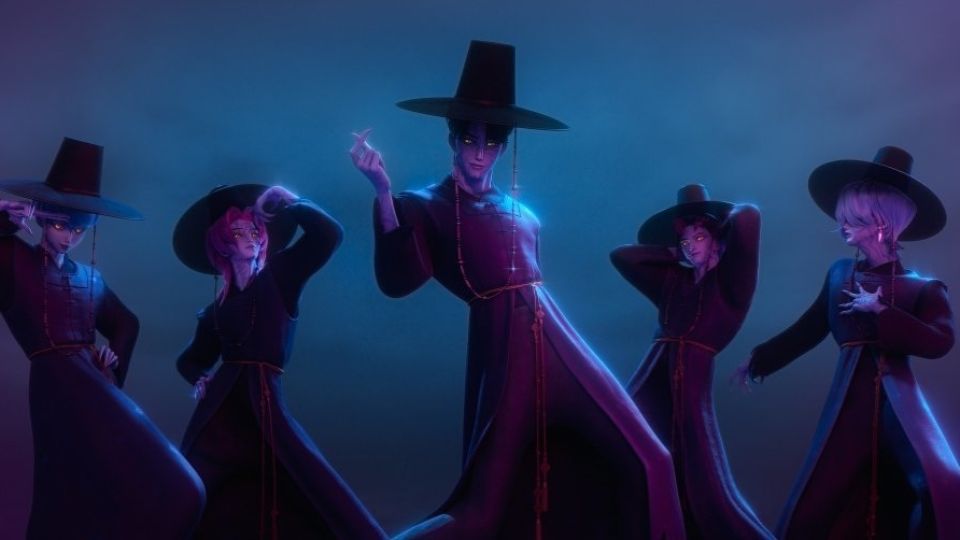The Necessity of Politicized Hybridization in the Local Cultural Industries
Dal Yong Jin / Simon Fraser University

In the Summer of 2025, people in many countries enjoyed K-Pop Demon Hunters, an animated film. K-Pop Demon Hunters follows the story of Huntr/x, a female K-Pop idol who also serve as secret guardians of the world (Figure 1). These idols protect their fans from supernatural threats posed by their villainous counterparts, the Saja Boys (Lee, 2025) (Figure 2). The film’s music — K-pop — has been a key element of its success. Global media outlets, cultural creators, and cultural consumers ask why this screen culture, which portrays K-pop as the film’s primary component, has achieved such global popularity. Numerous elements contribute to the success, including high-quality production skills, dazzling visual images, humor, and well-structured plots.
Many media scholars and global media outlets also argue that K-Pop Demon Hunters (hereafter KeDeHun) has been globally popular due in large part to the hybridization between Korean cultural scenes and American animation techniques and culture. KeDeHun did not adopt a conventional norm of hybridization but instead redefined the form of hybridity. As is well-articulated, hybridization is an alternative theoretical framework to cultural imperialism, referring to the asymmetrical power balances between the U.S. and other countries in the realm of popular culture (Schiller, 1976). Hybridity, by contrast, is an interpretive and reflective mode in which assumptions of identity are interrogated (Bhabha, 1994, 53-54), with local forces playing a pivotal role in developing local culture amid hybridization. Homi Bhabha (1994, 217-218) especially points out that hybridity must open up “a third space” in which diverse elements encounter and transform each other, signifying the “in-between,” an incommensurable location where minority discourses intervene to preserve their particularity. Several postcolonial scholars (Bhabha, 1994; Pieterse, 2009) believe that local cultural industries can develop unique local cultural content by mixing American and national cultural components rather than merely consuming American culture, thereby resisting American dominance.

Over the past several decades, the hybridization process has been viewed from two distinct perspectives: the depoliticization of hybridity and the politicization of hybridity. On the one hand, after analyzing Japanese popular culture in Asia, Iwabuchi (2004) and Lu (2008, 175) argue that local culture must shed much of its original cultural odor to succeed in the global cultural markets, becoming a neutralized product to gain wider audience reception. The concept of odorless cultural products represents popular culture’s depoliticized internationalization, one of the main reasons for the global success of certain local cultures (Lu, 2008). In fact, some non-Western hybrid cultures have erased their distinctiveness to appeal to global audiences. By attempting to create culturally neutral content, they have drawn criticism that cultural hybridity theory lacks a clear (cultural-) political stance (Jin, 2016).
On the other hand, hybridization can also be understood as one of the most distinctive forms of cultural politics. For some, it is strategically embedded in cultural politics because it relates to cultural policy, the division of cultural labor, and history. Hybridity especially reflects power relations between Western and non-Western states, often resulting in the appropriation of global goods and services by local forces to create borderless cultural content. The reality is that political culture underpins cultural production and consumption, since power relations between the global and the local forces remain uneven. This hybrid dynamic represents the politicization of local culture (Jin, 2016). Hybridity is not neutral. Negotiation occurs between Western and non-Western cultures “as spaces for creating new cultural representations or for witnessing the coexistence of a number of cultures” (Yoon 2009, 105); however, this negotiation process is not equal.

KeDeHun demonstrates the significance of politicized hybridity rather than emphasizing Western values, such as capitalism, individualism, and heroism. By skillfully blending Korean and American culture, this animated film has become one of the most successful examples of hybrid cultures. Its forms of hybridity are unconventional. To begin with, its producers and directors are multinational, incorporating diverse cultural components. The leading production company is Sony Pictures Entertainment, headquartered in the U.S., but its parent company is Sony of Japan. Both the U.S. and Japan are among the most advanced countries in animation, and their production skills are clearly reflected in the film. The directors are also multinational: Maggie Kang, a Korean Canadian, and Chris Appelhans, an American director, collaborated on the project. As films like Minari (2020) and Past Lives (2023) demonstrate, many Korean diaspora creators focus on Koreanness rather than erasing local identities, a factor that contributes to their global popularity. Korean American creators play a significant role in such productions, and their insider-outsider perspective often gives the films their distinctive character—something that might be harder to achieve in a purely domestic production (Moon, 2025). That dual perspective may explain why these films feel so balanced.
Maggie Kang, who wrote the script, deliberately emphasized numerous major Korean characteristics within the plot, visual images, and storylines. K-pop, which has gained global popularity in the 21st century, is again central to the film. Kang was inspired by “the K-pop idols she admired growing up. K-pop is the film’s heartbeat. The group’s music becomes a supernatural weapon that wards off dark forces. Each original track amplifies emotional moments….The music was woven into the narrative in a way that enhanced it rather than distracted” (Lee, 2025). The film also incorporates a variety of local elements, including scenery (Namsan Tower), mascots (Derpy the tiger and Sussy the magpie), and foods (such as cup ramen), all of which highlight Korean specificity (Figure 3). Thus, KeDeHun employs hybridity by combining traditional Korean folk elements and K-pop culture with Western animation; however, the hybridization process is unprecedented. While some industry experts argue that Korean cultural programs must eliminate local components unfamiliar to global audiences, KeDeHun proves that incorporating Korean elements has been one of the most significant contributors to its success. Of course, it remains an open question whether the politicization of hybridity, which emphasizes local identity, can ultimately resolve the imbalanced power dynamics between Western countries, particularly the U.S. and non-Western countries.

Global audiences in the 21st century do not seem to enjoy cultural products that erase local specificities. Instead, they prefer content that affirms local cultural identity. The lesson is clear: as the Korean Wave faces questions of creative stagnation, hybrid works like KeDeHun suggest a new path forward—one in which cultural blending drives innovation rather than compromise (Moon, 2025). What KeDeHun proves is that losing cultural specificity in the hybridization process is no longer a viable option in contemporary cultural production. By integrating cultural creators, backgrounds, and talents from multiple countries, KeDeHun shows that hybridity, understood not in its traditional form but as a new norm, can enhance the global flow of popular culture.
Image Credits:
- Huntr/x members Rumi (Arden Cho), Mira (May Hong), and Zoey (Ji-young Yoo) perform
- K-pop Demon Hunters features the Saja Boys performing “Your Idol”
- Mira, Rumi, and Zoey are eating cup ramen
- Tiger Derpy as the symbol of Koreanness
Bhabha, Homi. (1994). The location of culture. New York, NY: Routledge.
Iwabuchi, Koichi. (2004). “How Japanese is Pokémon?” In Pikachu’s Global Adventure: the rise and fall of Pokémon, ed. Joseph Tomlin, 53-79. Durham, NC: Duke University Press.
Jin, Dal Yong (2016). New Korean Wave: transnational cultural power in the age of social media. Urbana, IL: University of Illinois Press.
Lee, Julie Yoonnyung. (2025). KPop Demon Hunters: How the Netflix film became a global sensation. BBC. 16 July.
Lu, Amy Shirong. (2008). “The Many Faces of Internationalization in Japanese Anime.” Animation: an indisplinary journal 3(2): 169-187.
Moon So-young (2025). The power of hybridity behind ‘KPop Demon Hunters’ and ‘King of Kings’. Korea JoongAng Daily. 18 July
Pieterse, Jan Nederveen. (2009). Globalization and Culture: Global Mélange. 2nd ed. Rowman & Littlefield Publishers.
Schiller, Herbert. (1976). Communication and Cultural Dominance. New York: International Arts and Sciences Press.
Yoon, Ae Ri. (2009). “In-between the Values of the Global and the National: the Korean animation industry.” In Cultural Studies and Cultural Industries in Northeast Asia, eds. Berry, Chris, N. Liscutin, and J. Mackintosh, 103-115. Hong Kong: Hong Kong University Press.
I did wonder why K-Pop Demon Hunters is such a phenomenon not just globally, but cross-generationally, so thank you Dr. Jin for the discussion of KPDH as (successful) hybridization. Thinking of hybridization in this sense as preserving, rather than draining, or plasticizing, to play on Kristen Warner’s conception of plastic representation, the local is helpful in also thinking about where industrial and production powers are located, how distribution factors into reception, and the forecast about animation as possibly overtaking live-action film in terms of profitability and popularity. KDPH is such a great example of the particular and the universal in one, I guess, transcultural product.
Thank you for this piece!